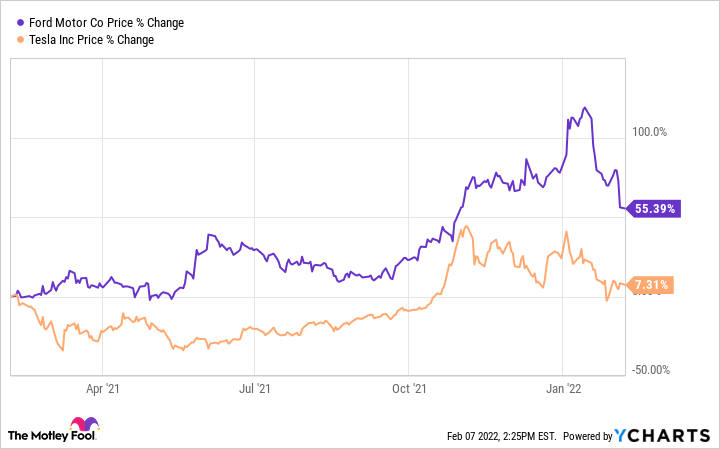Electric vehicles (EVs) are one of the top investing trends right now. With the immense wealth created for Tesla investors over the past decade, many investors are looking at other automotive companies that could provide similar returns for shareholders. Seeing the gigantic value the market has assigned Tesla, and the hundreds of thousands of vehicles it is now selling each year, legacy automotive companies have sped up production to get their own electric vehicles (EVs) out to customers.
Ford (F 0.08%) is one of these companies. The 118-year-old Detroit automaker is investing tens of billions of dollars to ramp up EV production and is seeing great early signs of demand for its EV product lineup. These early signs of success have changed investor sentiment on Ford stock, with shares up 54% in the last year, actually outpacing the 7% return for Tesla over the same time period.
With Tesla reaching a market cap of $1 trillion in late 2021, many investors are likely asking themselves if Ford can reach those same heights. Can Ford achieve a trillion-dollar market cap by 2030?

Image source: Getty Images.
Electric vehicle investments are bearing fruit
The majority of Ford's business right now is selling gas-powered cars. These include the popular F-150, Bronco, Explorer, and many other vehicles. While these products should bring in steady sales and profits for Ford over the next three to five years, its future is in EVs. This is where investors need to focus their analysis, as the company's success in the emerging industry will dictate whether the business is still relevant a decade from now.
Management is not taking the transition lightly. The company has committed to $30 billion in capital investments for EVs this decade. This includes $20 billion for car manufacturing and $11.4 billion for battery production (batteries are what makes EVs possible). These dollars will help scale Ford's many different EV products, which include the Mustang Mach-E and E-Transit work van. However, the most important product is by far the Ford F-150 Lightning.
The F-150 is the most popular car in America, making up 3% of total new car sales in 2021. Executing on bringing over this renowned product line to EVs is crucial, as there is a huge customer base for the brand across the United States.
While still in its early days (the first truck won't ship until the first half of this year), there are some signs the F-150 Lightning will sell well. The company already has 200,000 refundable deposits for F-150 Lightning reservations, which actually caused the company to stop taking new reservations for the time being. If this translates to broad customer demand once F-150 Lightning production scales over the next three to five years, Ford could have a hit on its hands.
The market opportunity is large but crowded
You can't fault investors for being bullish on the electric vehicle industry, as there will likely be trillions of dollars spent by consumers on EVs over the next few decades. According to analyst estimates, EV unit sales will pass 10 million in 2022, making up a good portion of the 60 million to 70 million in annual car sales worldwide. At an average selling price (ASP) of $25,000, 10 million EV unit sales equate to a $250 billion revenue opportunity. At 50 million annual sales, that means a $1.25 trillion annual revenue opportunity.
This might make you bullish on Ford's EV opportunity, as it is one of the leading automakers in the United States. But internationally, it has yet to break into any region, with less than 10% market share in every region outside North America and only 5.1% global market share in 2021. And with so many well-capitalized competitors worldwide, such as Toyota, Volkswagen, Tesla, and the Chinese carmakers, gaining meaningful market share will be a tough hill for Ford to climb.
Is a $1 trillion market cap in the cards?
In 2021, Ford did $136.6 billion in sales, making it one of the largest companies by revenue in the United States. Compared to its market cap of $71 billion, that might make the stock seem cheap, especially if you are bullish on its EV plans.
However, you should remember that automotive manufacturers have very low profit margins (Ford had an adjusted EBIT margin of just 7.3% in 2021) and a recurring need for sizable capital expenditures. This makes it difficult for automotive companies to generate much higher than 5% free cash flow margins for shareholders and is why they are typically valued at a price-to-sales ratio (P/S) under one.
Ford can provide solid returns for shareholders through steady dividend payouts -- the current yield is 2.24% -- and incremental increases in annual profits. But unless it dominates the entire global automotive industry and/or invents a highly profitable new business line, don't expect Ford to reach a market cap of $1 trillion by 2030.






